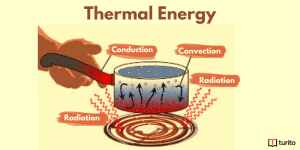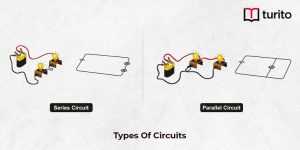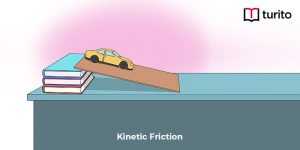Lenz law has been named after the scientist Emil Lenz. It is based on Newton’s third law of motion and the principle of conservation of energy. The direction of induced current can be most conveniently determined by this law.
What is Lenz’s Law?
The Lenz law definition: According to Lenz’s Law, “Electromotive forces of different polarities give rise to a current whose magnetic field is in a direction opposite to the magnetic flux change across the loop. This ensures that when current flows through the loop, the original flux through it is maintained.
As mentioned above in the Lenz law definition, this law is based on the third law of motion by Newton and the principle of conservation of energy.
Lenz’s Law Formula
The Lenz law formula can be derived from the formula of the law of Faraday. It is expressed as:

Here,
ε represents the voltage induced. It is also called electromotive forces,
Δϕ stands for the magnetic flux change,
N represents the number of loops,
Δt stands for the change in time.
Applications of Lenz’s Law
There are many applications of Lenz’s Law. Following are some of them:
- Card readers are a Lenz law example.
- Metal detectors
- A.C. generators
- Microphones
- Eddy current balance is a Lenz law example.
- Eddy current dynamometers are also a Lenz law example.
- Braking systems on train
Lenz’s Law Experiment
Lenz’s law can be employed to determine the direction of the electromotive force induced and the current that is generated by it. Several experiments can be performed based on this law.

First Experiment
In his first experiment, Lenz concluded that magnetic field lines are generated when current flows through the coil and completes the circuit. The magnetic flux increases with the increase in the increase in the flow of current through the coil. The induced current flows in a direction that opposes the change of magnetic flux.
Second Experiment
In his second experiment, Lenz concluded that an induced current is generated if we wind up a coil-carrying current on an iron rod, and its left end behaves as an N-pole, and it is moved towards the S of the coil.
Third Experiment
In his third experiment, Lenz concluded that when we pull the coil carrying current towards the magnetic flux, the coil’s area inside the magnetic field decreases. Lenz’s law states that the coil’s motion is opposed when we apply the induced current in the same direction.
A force is applied by the magnetic in the loop to generate current. The magnet current must also exert a force on it to oppose the change.
Other Important Laws in Physics
Clausius Statement
It states that,
“We can not design a device that operates on a cycle and does not produce an effect other than a transfer of heat from a cold to a hot object or physical body.” This means that the transfer of heat energy occurs spontaneously in the direction in which the temperature decreases. Suppose a refrigerator that works without any work input cannot be constructed.
This statement can be demonstrated by the fact that a refrigerator with a coefficient of performance equaling infinity cannot exist.
Kelvin-Planck Statement
This statement is a modification of the second law of thermodynamics, which states that “we cannot produce a device that works on a cycle and does not produce any effect other than heat transfer from a single object to perform work.” This indicates that we cannot construct an engine whose only purpose is to change the heat from a source or reservoir with high temperature into a work of equal amount.

It is a known fact that work and heat are two forms of energy. Both of them can be converted into each other and follow the same S.I. unit, that is, Joules. In this case, we can convert work fully into heat, but vice versa is not possible. Therefore, we can call heat low-grade energy and work as high-grade energy.
The Kelvin-Planck statement is a combination of two different statements given by two different scientists called Planck and Kelvin. Therefore, they are referred to as Planck’s statement and Kelvin’s statement.
According to Kelvin’s statement, it is impossible to produce a mechanical effect out of any matter by decreasing its temperature below the highest cooling temperature of the objects around it.
According to Planck’s statement, the sum of all the entropies of a reversible system stays constant.
The Kelvin-Planck statement was derived by clubbing these two statements.
Law of Conservation of Mass
This mass was discovered by Antoine Laurent Lavoisier in the year 1789. According to the law of conservation of mass, “Within a closed system, the mass remains unchanged over a given time”. Therefore, in an isolated system, mass can neither be generated nor eliminated but can be converted from one form to another. For low thermodynamic processes, the mass of reactants equals that of the products.
This law was later modified based on the concepts of quantum mechanics and special relativity, according to which mass and energy are a single conserved entity.
The formula of the Law of Conservation of Mass:
By using the continuum mechanics and the continuity equation in fluid mechanics, the law of conservation of mass can be expressed as,

Fourier’s Law
It is a known fact that heat conduction occurs on the vibration of the matter molecules. The transfer of heat energy occurs from an area of high temperature to an area of lower temperature. Fourier’s law is followed by this phenomenon. It is also known as the law of thermal conductivity.
According to Fourier’s law, “The temperature’s negative gradient and the rate of heat transfer against time corresponds to the area perpendicular to that gradient across which the heat energy flows. Fourier’s law is also referred to as the law of heat conduction.
Ohm’s law and Newton’s law of cooling are electrical analogues of the law of Fourier.
Electromagnetic Induction of Faraday’s Law
This law is fundamental to the concept of electromagnetism. It helps us understand the interaction of a magnetic field with an electric circuit that results in the production of an electromotive force or emf. This phenomenon is called electromagnetic induction.
There are two laws of electromagnetic induction, which were given by a physicist named Michael Faraday in 1831. These were the results of his observations based on his experiments. He carried out three main experiments to discover the concept of electromagnetic induction. Faraday’s laws have many applications, such as in the working of electrical equipment like transformers and induction cookers, for recording the velocity of fluids, and the working of electric guitars and violins.
Faraday’s First Law of Electromagnetic Induction
This law states that when a conductor is kept in a changing magnetic field, the induction of an electromotive force occurs. A current is induced in the conductor circuit if it is closed. This current is referred to as induced current.
Faraday’s Second Law of Electromagnetic Induction
This law states that the induced electromotive force in a coil equals the rate of change of the magnetic flux linked with it.
Conclusion
In the article, we have tried our best to explain Lenz’s law and all the major concepts related to it. In addition, we have also precisely discussed some other important laws in Physics. We hope when you are finished reading it, you will be able to answer most of the questions based on these concepts such as explaining Lenz law, Lenz law formula, Lenz law definition, and so on.
Frequently Asked Questions
Q) How is Lenz’s law based on the conservation of energy?
A) According to Lenz’s law definition, the direction of the induced current is always opposite to the electromotive force that produces it. Lenz’s law explained that the work needs to be performed against this opposing force which results in the alteration in the value of magnetic flux and induction of current. The name given to this extra work performed is electrical energy; therefore, the law of energy conservation is followed.
Q) State the difference between Lenz’s law and Faraday’s law.
A) While Lenz satisfies the law of conservation of energy and applies electromagnetic induction, Faraday’s law corresponds to the electromagnetic force generated.
Q) Mention the main importance of Lenz’s law.
A) The direction of the induced current is determined by Lenz’s law very conveniently. Therefore, this law is mainly important because of this application.
Q) What does the negative sign in Lenz’s law indicate?
A) The formula of Lenz’s law contains a negative sign which indicates that the electromotive force induced is in a direction opposite to that of the magnetic flux associated with the coil.
Q) Where is Lenz’s law mainly employed?
Lenz’s law is mainly employed while explaining how electromagnetic circuits follow the third law of Newton and the law of conservation of energy as Lenz’s law explained these concepts very clearly.

Relevant Articles
Understanding Thermal Energy: What It Is and How It Works
Thermal energy is essential to our daily lives, from warming …
Understanding Thermal Energy: What It Is and How It Works Read More »
Read More >>Avogadro’s Number: Meaning, Importance, and More
Introduction The concept of measuring the microscopic particles that make …
Avogadro’s Number: Meaning, Importance, and More Read More »
Read More >>Kinetic Friction – Definition, Laws, Types
Kinetic Friction Kinetic force is a force acting between two …
Kinetic Friction – Definition, Laws, Types Read More »
Read More >>




















Comments: